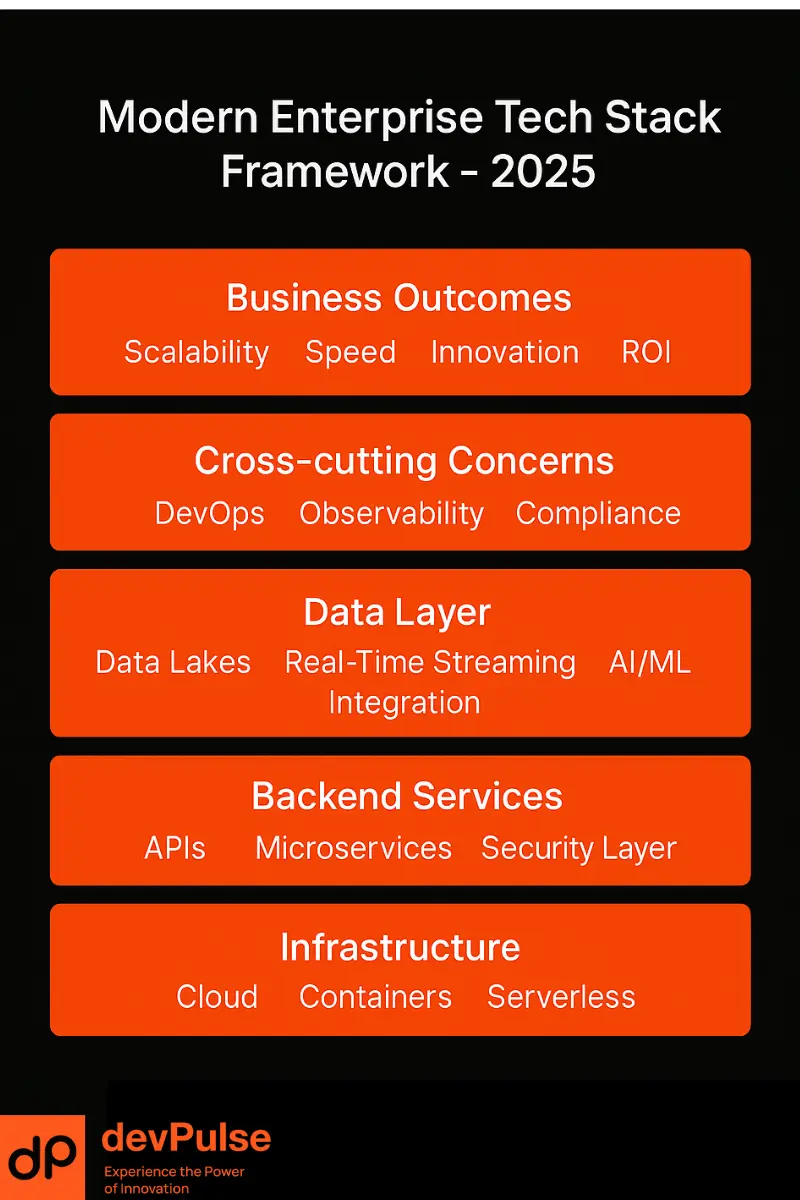Updated March, 2025
Staying competitive in 2025 requires more than just adopting trendy technologies. It demands a cohesive, future-proof architecture that aligns with your business objectives and keeps pace with rapidly shifting market conditions. This guide offers a consultative framework for building-and continuously optimizing-a modern enterprise tech stack. Along the way, we’ll highlight real-world examples, discuss emerging best practices, and provide actionable insights drawn from recent industry research and our own experience helping organizations modernize their IT ecosystems.
Key Takeaways at a Glance
- Balance is Key: Adopting every new tool can overcomplicate your stack, yet ignoring innovation leaves you vulnerable. Strive for a stack that supports immediate business goals and remains flexible for future needs.
- Security & Compliance: Building zero-trust and robust governance into your architecture from day one reduces breach costs and safeguards customer trust.
- DevOps & Team Structure: Organizational design shapes technology outcomes. Streamlined teams with clear ownership can accelerate deployments and reduce overall maintenance.
- Data & Intelligence: Real-time data processing, AI integration, and microservices all hinge on a solid data architecture. Don’t let legacy systems block transformation.
- ROI Matters: Measure success through technical metrics (uptime, latency), developer productivity (deployment frequency, time to recovery), and direct business impact (customer satisfaction, revenue growth).
Understanding the Real Impact of Tech Stack Choices
A well-chosen tech stack can fuel rapid feature releases, maintain strong security, and adapt to ever-changing market demands. Conversely, a misaligned stack drains resources, stifles innovation, and frustrates your teams. One global manufacturer learned this lesson the hard way: after selecting a cloud platform that couldn’t meet their data-processing needs, they spent six months and $2.3 million fixing performance issues-while their competitors delivered major new features in that same window.
Why It Matters for Enterprises
- Time-to-Market: A flexible, well-structured stack can cut release cycles from weeks to days.
- Cost Efficiency: Modernizing legacy systems often reallocates 60-80% of maintenance budgets toward innovation.
- Risk Management: Outdated architectures hamper security updates, leaving you exposed to breaches and regulatory penalties.
Every technology decision you make today shapes your speed, security, and scalability tomorrow.For more insights on why legacy systems pose an immediate threat to business agility, see our Legacy System Modernization Guide.

The 2025 Technology Landscape: Trends & Challenges
By 2025, AI-driven features have gone from “nice to have” to “mission-critical.” Edge computing is reshaping how data is processed and consumed, especially for IoT devices in manufacturing or retail settings. Meanwhile, containerization (e.g., Kubernetes) and serverless approaches keep gaining traction for their scalability and operational efficiency.
According to Gartner, the average enterprise uses 367 different applications to manage operations-underscoring the need for unified integration strategies. And McKinsey research shows organizations with adaptable architectures deploy new features 4x faster than those relying on monolithic systems.
Common Challenges
- Fragmentation: Disconnected legacy apps force expensive manual integrations.
- Skill Gaps: New technologies (AI, containers, low-code) require upskilling or new hires.
- Compliance Pressures: Heavily regulated sectors must ensure data privacy across globally distributed systems.
- Technical Debt: Maintaining aging systems siphons budget away from forward-facing initiatives.
Foundation Principles of Modern Tech Architecture
1. Align Technology with Business Goals
Every technological choice should directly support your business objectives-whether it’s reducing customer churn or expanding into new markets. Netflix’s cloud migration, for instance, wasn’t just a “lift-and-shift” to AWS; it was a deliberate strategy to improve global streaming quality and accelerate expansion. Likewise, in our own Digital Transformation Solutions, we see companies thrive when they tie technical decisions to specific business outcomes (e.g., faster time-to-market or increased user engagement).
Ask Yourself
- What specific business capability does this technology unlock?
- How will it affect customer satisfaction or operational efficiency?
- Does it advance our near-term growth and support future plans?
2. Embrace Flexibility-But Beware Complexity
Flexible architectures adapt to changing requirements. Stripe evolved from a simple Ruby monolith into a set of specialized services (fraud detection, identity verification) only when scaling demanded it. Starting with an overly complex microservices setup too soon often spawns immediate technical debt. Choose the simplest architecture that meets today’s needs while leaving room to grow.
3. Security & Compliance by Design
Security woven into the architecture from day one is far cheaper than retrofitting it later. According to the IBM 2023 Cost of a Data Breach Report, zero-trust architectures save organizations an average of $1.5 million per breach.
Organizations with mature zero-trust saved $1.5M on average.
As your stack evolves, so do compliance requirements-especially in finance, healthcare, or cross-border e-commerce. Prioritize frameworks that streamline audits (e.g., ISO 27001, SOC 2) and automate threat detection where possible.
4. Seamless Integration Capabilities
Integration isn’t optional when the average enterprise uses hundreds of applications. Build your tech stack to communicate with third-party services, partner APIs, and future tooling. Shopify’s App Store ecosystem shows how a well-designed architecture can host thousands of integrations without compromising performance or security.
Core Components of a Modern Enterprise Tech Stack
A future-proof stack spans multiple layers, from the user interface to data storage and AI-powered analytics. Each layer is interdependent, but strategic decisions at each level can safeguard agility and long-term maintainability.
Frontend Architecture: Beyond Framework Choices
The frontend sets the tone for user experience. Airbnb’s shift to React in 2017 wasn’t just about chasing trends; it streamlined their design system and improved performance by 50%. Today, large-scale apps often pair frameworks like React or Angular with robust state management solutions. For enterprise-grade UI/UX, consider a design system approach-similar to Uber’s Base Web-to ensure consistency and speed development.
- State Management: Tools like Redux or Vuex handle complex data flows.
- Performance Optimization: Techniques such as code splitting, lazy loading, and modern image formats can cut page-load time dramatically.
- Cross-Platform Considerations: Frameworks like React Native or Flutter offer a single codebase for web and mobile, but weigh performance implications.
For more design-focused insights, see our UX/UI Design Best Practices for 2025.
Backend Infrastructure: The Engine Room
Backend services drive core logic, integrations, and data access. Monolithic architectures can be simpler initially but become a bottleneck at scale. Microservices-often orchestrated via Kubernetes-provide granular scaling and faster deployments but introduce complexity around service discovery, monitoring, and inter-service communication.
Key considerations:
- Service Architecture: Decide whether to start monolithic and break out services over time, or adopt microservices from the get-go.
- API Strategy: Stripe’s renowned API approach balances backward compatibility with rapid iteration, ensuring minimal disruption for users.
- Resilience & Scalability: Auto-scaling on cloud platforms or using serverless functions helps handle traffic spikes (e.g., Black Friday retail surges).
If you’re contemplating a broader cloud migration, check out our Cloud Migration Strategy Guide for best practices on transitioning infrastructure.
Data Architecture: The Foundation of Intelligence
Real-time data processing is now essential for recommendations, analytics, and operational insights. Netflix processes billions of events daily to personalize content, while DoorDash uses streaming analytics to optimize deliveries in seconds.
Evolving patterns:
- Streaming Platforms: Apache Kafka or AWS Kinesis enable real-time data flows.
- Data Mesh: Organizing data by business domain can scale analytics and keep teams autonomous, as pioneered by Spotify.
- AI/ML Integration: Gartner forecasts that 70% of new applications will include AI by 2025. Ensure your data pipelines can feed machine learning models-often deployed via containerization or serverless for speed and cost-effectiveness.
Tech Stack Implementation Strategy: From Theory to DevOps
A solid architectural vision is only half the battle. How you implement and iterate determines real outcomes.
- Start with Clear Priorities
Notion’s rebuild in 2018 focused single-mindedly on reducing page-load times. For your organization, identify one or two critical metrics-like time-to-market or customer onboarding speed-and let them guide technology decisions. - Adopt DevOps Practices Early
Seamless collaboration between development and operations teams reduces friction. Automated CI/CD pipelines shrink release cycles and mitigate deployment risks. Our DevOps Implementation Guide for 2025 details how cross-functional teams can automate testing, integrate feature flags, and maintain reliability at scale. - Phased Rollouts
Slack’s evolution from a gaming chat app to a business communication platform exemplifies incremental architecture changes. Move step by step:- Phase 1: Stabilize the foundation-ensure reliability, basic observability, and strong testing.
- Phase 2: Improve scalability-introduce caching, optimize databases, and adopt container orchestration like Kubernetes where it yields clear benefits.
- Phase 3: Accelerate features-microservices, AI-driven insights, advanced automation.
- Stay Observant & Adaptive
Observability tools (e.g., New Relic, Datadog) provide end-to-end performance metrics and alerting. Mature observability practices help you pinpoint issues faster, reducing mean time to recovery by up to 60%. Frequent retrospectives keep teams aligned on continuous improvement.
Your tech architecture will mirror your team structure. (Conway’s Law)
Security & Compliance: The Non-Negotiable Foundations
Security threats are more sophisticated than ever. A single data breach can shatter trust and incur hefty fines. After the 2023 LastPass incident, many organizations realized compliance alone isn’t enough; a zero-trust mindset is paramount.
Building Zero-Trust
- Identity as Perimeter: Tools like HashiCorp’s Vault manage secrets and automate access control.
- Microsegmentation: Google’s BeyondProd model enforces secure service-to-service communication, reducing breach impact.
- Automated Testing & Audits: Integrate security scans into CI/CD to catch vulnerabilities before production deploys.
Compliance and Governance
Regulated industries (finance, healthcare) face additional oversight. Even general enterprises must meet data privacy standards (GDPR, CCPA) if they operate internationally. Architect your systems to keep data localized where regulations require, and build robust auditing capabilities from the start. Our Digital Transformation Guide addresses how governance can align with rapid tech adoption.
Measuring & Optimizing Success
Traditional Metrics Aren’t Enough
Uptime and response time matter, but modern enterprises track deeper KPIs: error budgets, developer productivity, and direct business outcomes. Google’s SRE framework popularized service-level objectives (SLOs) that measure performance from the user’s viewpoint (e.g., request latency, availability per region).
Developer Experience
GitHub monitors build speed and deploy frequency to ensure their tech stack remains developer-friendly. Faster deployments correlate with rapid feedback loops and higher feature velocity.
Capital One reduced deployment times from 3 months to minutes after modernizing on AWS
Business Impact
Connect technology metrics to revenue, customer retention, or user satisfaction. Etsy’s search improvements didn’t just reduce latency; they boosted conversion by 12%. Stripe ties API performance to transaction success rates-directly influencing revenue.
Continuous Optimization
- Performance Tuning: Netflix’s Node.js optimization cut startup time by 50%. Consider periodic “chaos engineering” to stress-test resilience.
- Cost Reduction: AWS or Azure usage can balloon if unmonitored. Automated scaling policies and resource tagging keep budgets in check.
- Security Hardening: Regularly update threat models, patch dependencies, and conduct penetration tests. Emerging quantum-safe cryptography may soon be essential for long-term data protection.
Building Your Path Forward
A modern enterprise tech stack isn’t a fixed destination-it’s a mindset of continuous evolution and alignment with your organization’s goals. Throughout this guide, we’ve seen how companies like Netflix and Stripe tailor their architectures to scale with their business. We’ve also identified pitfalls such as over-engineering, ignoring compliance, or failing to measure real ROI.
Here’s How to Get Started
- Audit Your Current Stack: Document major components, pain points, and maintenance costs.
- Prioritize Business Outcomes: From reducing churn to entering new markets, clarify your biggest opportunities.
- Implement in Phases: Tackle one or two critical improvements-like adopting DevOps practices or containerizing a core service-then iterate.
- Monitor & Refine: Track meaningful metrics, from developer velocity to security incident response times. Make continuous improvements part of your culture.
Above all, remember: the best tech stack isn’t defined by the latest frameworks, but by how effectively it enables your enterprise to innovate, adapt, and grow.
Ready to Accelerate Your Tech Evolution?
Whether you’re modernizing an existing stack, exploring containerization for real-time data services, or need guidance with AI integration, DevPulse has the expertise and hands-on experience to help you execute with confidence. Contact Us to learn how we tailor technology solutions for your specific business objectives-without unnecessary complexity or hype.





